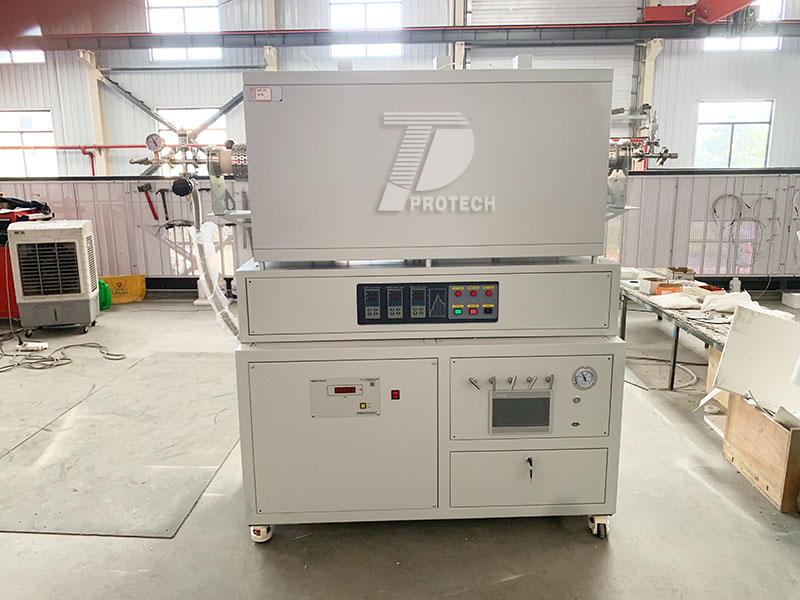


NEWS
CVD (Chemical Vapor Deposition) furnace is a device used to generate solid thin films on the surface of substrates through chemical reactions. It mainly has the following characteristics:

Commonly used CVD furnaces (click on the image to view product details)
High flexibility: CVD furnaces can adapt to a variety of different materials and film preparation needs. By adjusting parameters such as the type, flow rate, temperature, and pressure of the reaction gas, the composition, structure, and properties of the thin film can be precisely controlled, thereby preparing materials that meet different application requirements.
High temperature and high pressure environment: CVD furnaces usually undergo deposition process in a high temperature and high pressure atmosphere. High temperature environment helps to promote the diffusion of reactants and increase the reaction rate, while high pressure environment helps to control the reaction atmosphere and prevent gas leakage.
Precise temperature control: The CVD furnace has a precise temperature control system that can achieve precise temperature control of the reaction area. This temperature control capability has a significant impact on the uniformity and quality of deposited thin films.
Controllable gas phase composition: The CVD furnace can adjust the composition of the reaction gas phase by controlling the flow rate and mixing ratio of the feed gas. This controllable gas-phase composition also has a significant impact on the composition and properties of deposited thin films.
Can prepare high-quality thin films: CVD furnace can prepare uniform, dense, and high purity thin film materials. This is because the CVD process takes place in the gas phase, where reactants can be fully mixed and reacted, avoiding the introduction of impurities, and achieving ideal film quality can be achieved by accurately controlling reaction conditions.
Suitable for complex shaped substrates: CVD furnaces can adapt to substrates of different shapes and sizes, including flat, curved, porous structures, etc. This enables CVD technology to be widely applied in the preparation of various materials and devices, such as semiconductor devices, optoelectronic devices, nanomaterials, etc.
High deposition rate: Due to the high-temperature and high-pressure environment and precise control system, CVD furnaces can achieve high deposition rates, usually reaching the order of several nanometers to several micrometers per minute.
Multiple deposition materials: CVD furnaces can deposit various types of materials, including metals, oxides, nitrides, carbides, etc., which can meet the needs of various application fields.
Widely applicable: CVD furnaces have a wide range of applications in semiconductor devices, optical thin films, functional coatings, nanomaterials, and other fields, providing important technical support for material preparation and functional improvement.
Strong scalability: The design structure and operation mode of CVD furnace have a certain degree of flexibility and scalability, which can meet the experimental and production needs of different scales and process requirements.
Can be combined with other technologies: CVD furnaces can be combined with other technologies, such as physical vapor deposition (PVD), ion beam sputtering, etc., to form composite technologies. This combination can further improve the performance and preparation efficiency of materials, meeting more complex application requirements.
Environmental Protection and Energy Conservation: CVD furnaces typically use gas as a reactant during the preparation process, which reduces the generation of wastewater and solid waste compared to traditional solid-phase or liquid-phase preparation methods. In addition, by optimizing reaction conditions and equipment design, energy consumption and environmental pollution can be further reduced.
Easy to automate and intelligently control: With the development of modern control technology, the automation and intelligentization level of CVD furnaces continues to improve. By precise control of reaction conditions, real-time monitoring of the reaction process, and automatic adjustment of equipment parameters, a more efficient, stable, and reliable thin film preparation process can be achieved.

Multi temperature zone high-temperature CVD furnace(click on the image to view product details)
Therefore, CVD furnaces have the characteristics of high flexibility, the ability to prepare high-quality films, suitability for complex shaped substrates, ease of large-scale production, integration with other technologies, environmental protection and energy conservation, and ease of automation and intelligent control. These characteristics have made CVD furnaces widely used in materials science, semiconductor industry, optoelectronic devices and other fields.Click to learn more CVD devices! Or click on online customer service to learn more about product information!
Leave A Message